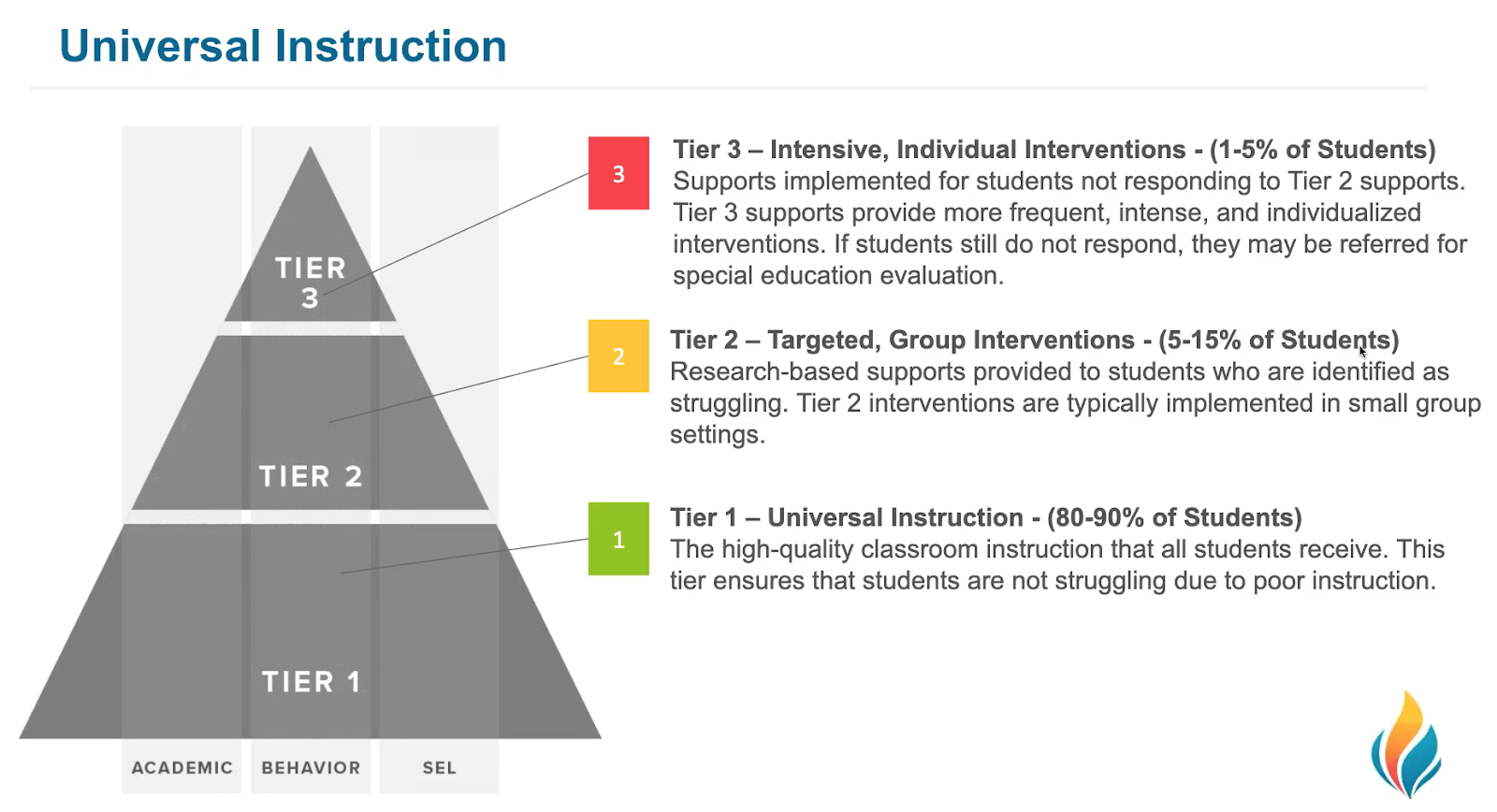Screening Scores
Universal screening involves having all students in each grade complete the same brief assessment, and most students with disabilities can participate in universal screening. The purpose of screening is to identify students who might need additional assistance in order to reach learning goals. Although students with disabilities who are provided special education services might not meet the benchmark goals initially, the screening scores show how far away from the benchmark a student is. The screening score can be a starting point for determining the rate of improvement needed to reach the benchmark.FAST Benchmarks
FastBridge Learning® publishes benchmarks that are designed to show a student’s likelihood of reaching a later goal, such as a passing score on the state test. For academic skills, the FAST benchmarks include two risk indicators: (a) some risk, and (b) high risk.- The some risk score range includes scores that fall around the 15th through 40th national percentile ranks. The 15th and 40th percentiles are approximate because the actual score criterion varies slightly across FAST measures.
- The high risk is applied when scores fall below about the 15th national percentile. These benchmarks can be used to identify how far away from a grade-level goal a student’s score falls. It is important for students with disabilities to participate in universal screening at grade level as much as possible so that teachers can know the student’s present level of performance in relation to the grade-level benchmark.
Rates of Improvement (ROI)
FastBridge also publishes typical rates of improvement as part of its normative data. These ROIs are found in the norms tables in the FastBridge website. The ROI data help teachers know how much weekly growth is typical for students. This information can be used to design instruction that helps the student reach grade-level benchmarks. When setting goals, it is important that the expected ROI is actually feasible so that the student is likely to reach the goal when provided with the right instruction.Goals and Objectives
Once a target ROI is identified, a specific, measurable goal with objectives can be written. For example, consider the case of Skyler, a third grader with a specific learning disability in reading.Her fall score on CBMreading was 37 words read correctly (WRC). The third-grade fall benchmark is 90 WRC. Skyler’s current score is well below the benchmark and the team needs to decide whether her goal should be set at the third-grade level or lower.
As often as possible, FastBridge recommends that goals and instruction be at grade level. A review of the third grade ROI norms shows that the 50th percentile fall to winter rate is 1.5 words gained per week. Aggregate norms show that some students gained as many as 2 or more words per week.
If Skyler’s goal is written to reflect a goal of gaining 2 words per week for 32 weeks (the length of a school year), her goal would be a score of 101 WRC. The third-grade spring benchmark is 131 WRC. Even if she gains 2 words per week, Skyler, will not be able to catch up to meet the spring benchmark goal. Nonetheless, this gain would reduce the difference between her score and the benchmark by a number of points.
The fall difference was 53 WRC and the difference in the spring would be 30 WRC.
As noted, FastBridge recommends using grade-level goals and progress measures as much as possible. The FAST CBMreading passages were written so that there is considerable overlap between the grades. This means that third-grade passages will not be that much more difficult than second-grade ones. Since the goal is to help students make as much progress as possible, it is best to set a grade-level goal and monitor progress at grade level. In Skyler’s case, the goal statement could be:When provided with high-quality direct reading instruction, in 32 weeks Skyler will read 101 words correctly per minute on a third-grade curriculum-based measure of reading.
Notice that this goal reflects an ambitious but feasible amount of weekly reading growth rather than the third-grade spring benchmark. It is best to set attainable goals using the ROI norms rather than create goals based on benchmarks only. This is because there is an upper limit to the amount of growth that a student can make. It is unrealistic to expect that those students whose starting score is well below grade level will reach the benchmark, but they can make gains that will narrow the gap. This example used fall, winter and spring benchmarks and ROI norms to calculate the student’s goal. In many cases, the starting and ending points for IEP goals will be other than the fall and spring of a school year. Regardless of the starting and ending dates, the ROI norms and a 32-week time period can be used because these reflect the data and time frames for the typical school year. In cases when the student participates in an Extended School Year (ESY) program, the additional weeks of instruction should be included in the goal calculations. Remember to include only those weeks when instruction (e.g., school) is provided and not vacation weeks. When setting up progress monitoring with FAST there are options to carry over the goal to the next school year and to include ESY summer instruction, if needed.Progress Data
IEP goals should be accompanied by weekly progress monitoring. Indeed, the original curriculum-based measures were developed for the purpose of monitoring IEP goals. The choice of progress measure needs to match the specific learning goal.
For reading goals that relate to fluency, vocabulary and comprehension, CBMreading is an effective measure because it provides a strong indicator of the student’s reading growth in those areas. For reading goals that focus on phonemic awareness or phonics, selected FAST earlyReading subtests such as Letter Sounds or Nonsense Words are effective measures.
Math progress monitoring is different because the measurement tool must be very specific to the instruction. For example, if subtraction is the focus, using a progress measure that includes addition, multiplication and division can mask the true instructional effects. For this reason, it is very important to identify the skills being taught and make sure that the progress measure also covers those specific skills. FAST offers a suite of earlyMath tools as well as three types of CBMmath progress measures that can be used for math goals.
Progress data need to be reviewed at regular intervals in order to provide information about instructional effects. The scores can be reviewed each week after the student completes the assessment as well as when writing quarterly IEP reports. Some FAST progress measures can show whether instruction is working with six data points through FAST™ Projection. Others require 12 or more data points to indicate whether the instruction is working. If the progress data indicate limited to no growth at grade level, despite intensive, high-quality instruction, then a goal at a lower grade level can be set. When below-grade monitoring is used, remember to review the data regularly and, as soon as the student meets the goal, adjust the monitoring to be at the next higher grade level.
FAST screening and progress assessments can be used to assist with developing and measuring IEP goals. This is best done by starting with the student’s grade-level screening score and then calculating the difference between that score and the grade-level benchmark. Next, the team can examine the FAST ROI norms to learn how much weekly growth is possible. The ROI value can be multiplied by the number of instructional weeks covered by the IEP (e.g., 32) and added to the screening score to generate the student’s goal. This goal can then be included in the IEP goal statement. Smaller interim goals can be calculated as well to provide quarterly learning objectives.
FastBridge Learning recommends both grade-level screening and progress monitoring as often as possible because such practices are more likely to result in the student reaching grade-level standards. Only when a student’s starting level is significantly below grade level should lower-level goals and progress measures be used.



![[eBook] Get the Whole Picture: Using Social, Emotional and Behavioral Assessments to Support Student Success](https://5196620.fs1.hubspotusercontent-na1.net/hubfs/5196620/AdobeStock_157265506.jpeg)




